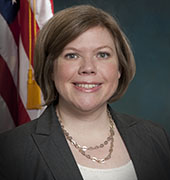
Elections and Campaign Finance
Federal agencies can strengthen efforts to help secure election infrastructure, oversee accessibility of voting for individuals with disabilities, and enforce campaign finance laws.
In the United States, federal laws regulate various aspects of election administration, including voter registration, and protecting the voting rights of individuals with disabilities and certain minority groups. However, states and over 10,000 local election jurisdictions are largely responsible for administering federal elections.
States regulate activities like voting methods, time periods for voting on or before Election Day, and voting equipment. On the other hand, local jurisdictions register eligible voters, design ballots, arrange for polling places, prepare voting equipment, and count ballots.
There are both benefits and challenges to how states and local elections offices administer various processes—as well as a number of opportunities to strengthen federal efforts.

Voter registration
Federal law requires that states provide certain voter registration opportunities, such as when an individual obtains a driver's license. States can also provide additional opportunities, such as online registration. Establishing infrastructure for online registration requires time and money, but can generate savings and enhance accuracy (such as by reducing the need for local election officials to manually process paper registration forms).
Federal law also requires states and local jurisdictions to maintain accurate voter registration lists, and they use different data sources and processes to do so. For example, some state elections offices collaborate with their state’s motor vehicles agencies to get information on address changes. Some participate in interstate exchanges to compare information from participating states’ voter registration lists. States also use national databases—such as the U.S. Postal Service’s National Change of Address database and the Social Security Administration’s public Death Master File—to identify registrants who have moved to another jurisdiction or state or who have died.
While these data sources can help improve list accuracy, they also have limitations. For instance, they may not capture all changes in registrants’ information (such as when people do not notify the U.S. Postal Service when they move).
Voting equipment
Much of the voting equipment acquired with federal funds through the Help America Vote Act in 2002 may be reaching the end of its life span. Some states and local election jurisdictions have or are considering replacing their equipment.
Some factors that jurisdictions and states consider include:
- The need for equipment that meets federal, state, and local standards and requirements
- The cost to acquire new equipment and availability of funding
- The ability to maintain equipment and receive timely vendor support
- The overall performance and features of equipment
Current federal guidelines can be used to test and certify voting equipment to verify that it meets baseline functionality, accessibility, and security requirements. Stakeholders, including state election officials and voting system vendors, had varying perspectives on how the guidelines affected the replacement and development of voting equipment. Some indicated that the guidelines are helpful for equipment developers and save states money because they do not have to duplicate federal testing. However, others said that aspects of these guidelines could discourage the development of innovative equipment and limit the choices of voting equipment on the market.
Voter turnout
Studies have identified various election administration policies that can affect voter turnout.
For instance, some studies have found that:
- Same-day registration and all vote-by-mail policies increase turnout
- Vote centers (polling places where registrants can vote regardless of assigned precinct) and using text messages to provide information about elections increase turnout
- Using e-mail and robocalls to provide information about elections do not affect turnout
Additionally, a 2014 review compared changes in voter turnout between the 2008 and 2012 general elections among selected states that had introduced more stringent voter identification requirements and those that did not. While all of the states studied had reduced turnout between the elections, states with more stringent voter identification requirements had larger reductions—and those reductions were greater for Black voters than for other racial and ethnic groups.
Election security
The Department of Homeland Security’s Cybersecurity and Infrastructure Security Agency (CISA) has helped state and local elections officials secure online voter registration systems, voting machines, and other election infrastructure since 2017.
To guide its support to states and local election jurisdictions for the 2020 elections, CISA was developing strategic and operations plans, but faced challenges in its planning efforts. CISA’s efforts also may not fully address all aspects of its strategic plan or identified challenges from its election security efforts during the 2018 elections (such as concerns about incident response).
Examples of Election Assets Subject to Physical or Cyber Threats

Voters with disabilities
Federal law generally requires all polling places for federal elections to be accessible to all voters, and have a system for casting ballots that is accessible for people with disabilities.
However, an examination of the accessibility of polling places for voters with disabilities during the 2000, 2008, and 2016 general elections points to the need for additional progress to help voters with disabilities enter and move through polling places, access voting systems, and cast a private and independent vote.
Additionally, the Department of Justice’s (DOJ) guidance does not specify the extent to which certain federal accessibility requirements are applicable to early in-person voting.
Polling Place with a Make-shift Ramp That Could Impede Voters with Disabilities

Campaign finance
The Federal Elections Commission (FEC) is responsible for civil enforcement of campaign finance law. It does this by administering the public disclosure system, promulgating regulations, and enforcing laws through audits, investigations, and civil litigation.
DOJ is responsible for investigating and prosecuting criminal violations of campaign finance law. Various types of campaign finance-related activities are subject to federal law and enforcement by both the FEC and DOJ.
While the FEC and DOJ coordinate on campaign finance, some of their coordination activities are not reflected in their Memorandum of Understanding (MOU)—which has not been updated since it was signed in 1977. Reviewing and updating coordination practices between the agencies, to include the MOU or other guidance, could help the agencies ensure consistent and effective coordination when enforcing campaign finance law.






